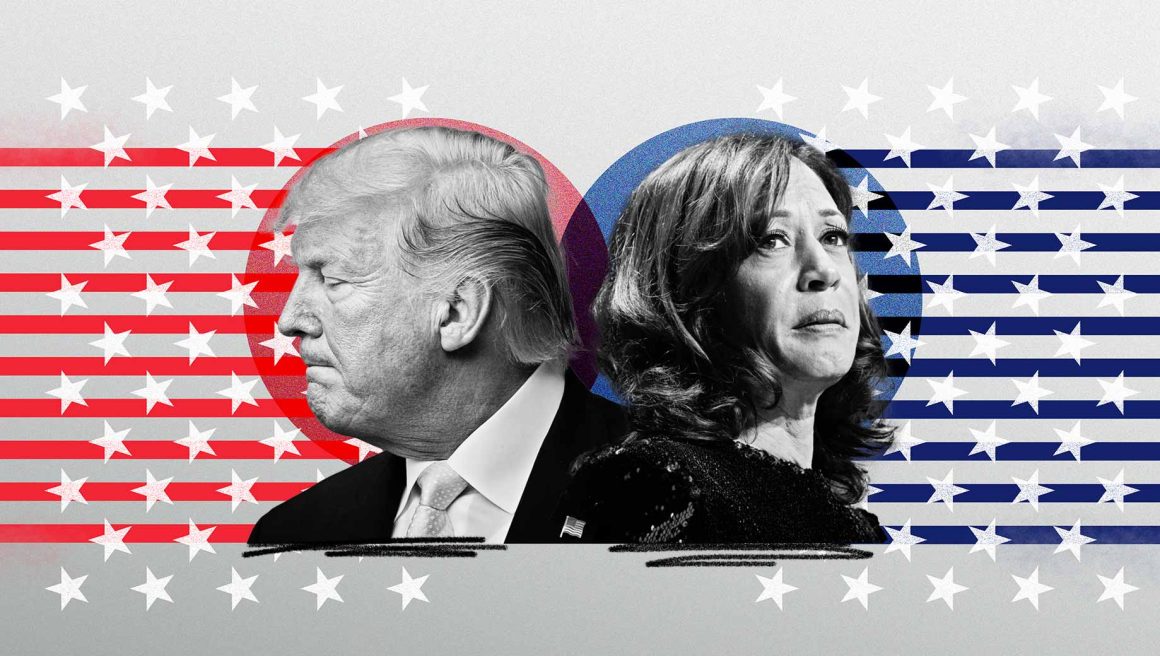By Harper Cleves
Ears bandaged in a Van Gogh-esque homage to Trump’s injury in a summer assassination attempt; attendees of the Democratic National Convention (DNC) decked out in white as a nod to the suffragettes; live streamed debates where the moderator has to clarify in real time that “murdering infants is illegal in all 50 states” when a fictional nine-month abortion is described.
The US elections are renowned for their pageantry and drama, but for many, the stakes of this election are especially high. On the one hand, the demagogic Donald Trump, with his dystopian policy plans and overt bigotry; on the other, the continuation of an administration that has overseen and actively contributed to a genocide which has slain hundreds of thousands of Palestinians in the past year. Understanding the context for this presidential election is crucial to envisioning its potential outcomes, but also for imagining an alternative to the unpalatable and dangerous charade of US corporate politics.
Economy for the bosses, at the expense of workers
In order to understand the circus of the US presidential elections, it is crucial to have a glimpse into what life is like in the United States today. Economic inequality is at an all-time high, even with the lowest unemployment rates in 54 years. In the first quarter of 2024, 67% of the total wealth was owned by the top 10% of earners, while the bottom 50% owned just 2.5%. One stark example of the impacts of wealth inequality, and the extent of the privatisation of resources that are essential to sustain human life, is healthcare: in 2022, 45% of Americans were unable to afford or access healthcare.
Trump, and successive US presidents before him, did nothing to alleviate the issue of inequality because it is born out of a reliance on the private market to provide for essential goods. “Bidenomics” – the economic policy of the Biden administration – has only widened this gap. Biden’s investments into infrastructure, as well as the subsidies given to electric car and semiconductor manufacturing, while contributing to modest economic recovery, is not aimed at putting money into the pockets of working-class Americans, but rather, revitalising domestic production in the context of a new Cold War with China by providing state funds to big corporations.
The sellout of the 2022 industrial action of railway workers clearly demonstrates Biden’s cosy relationship with corporations at the expense of working-class people, despite his self-proclaimed title as being the “most pro-union President in American history.” In this dispute, where over 100,000 railway workers across several unions threatened to strike in order to obtain a basic right to sick leave, Biden intervened using presidential powers that allow him to strike-break in the case of substantial disruption to interstate commerce, forcing a deal that most workers had rejected in order to keep corporate bosses happy.
Trump’s plan for a protectionist economic policy, while claiming to be focused on bringing jobs back to the US, will not resolve this issue and will also place big business interests first and foremost.
Young people lose out
Young people are especially impacted by these harsh economic realities. The 2024 annual World Happiness Report, developed from Gallup’s global polling, saw the United States at its lowest ever ranking, dropping for the first time outside of the top 20, landing at 23. The dissatisfaction of young people under 30 years old was predominantly responsible for the decline, with Generation Z respondents reporting feeling more stressed and dissatisfied with their living conditions. Young people have much higher rates of student debt, lower rates of home ownership, higher rates of rental prices and are more likely to live with parents or other roommates than previous generations.
However, other indicators include “feeling less supported by friends and family, and less free to make life choices.” These worrying phenomena cannot be separated from the slate of regressive laws being passed and the conscious scapegoating of women, queer people and people of colour at both state and federal levels, with millennials and Gen Z representing the most diverse generations in US history.
In 2024 alone, 642 anti-trans bills have been under consideration across the US ranging from topics like limiting bathroom usage, preventing access to gender-affirming care, to banning trans children from participating in sports. Since Roe V Wade was overturned, 14 states have enacted near total bans on abortion access resulting in pregnancy-related mortality rates over twice as high than in states with abortion access. In 2021 and 2022, 563 bills were introduced against teaching critical race theory in public schools.
The House of Representatives education and workforce committee, under the guise of reducing anti-semitism on college campuses in the midst of an international Palestine solidarity movement, is also coming up with creative ways to cut across Diversity, Equity and Inclusion (DEI) programmes; something which has been fueled by the conservative Supreme Court explicitly ruling against race-based affirmative action as a means of cutting across racial disparity and inequality on college campuses.
Biden-Trump: the original lose-lose battle
In this context of extreme crisis, it is no surprise that polarisation has flourished. Moderate policies that once seemed reasonable to the populace in more stable times, now expose themselves as completely insufficient. In a New York Times / Siena College poll from March, four times as many voters said they were angry, scared, disappointed, resigned, or apprehensive about this election as they were happy, excited, or hopeful about it.
Even with many despairing, it was clear that the Republicans had the advantage. The disaffection Trump has been able to tap into with his unique brand of right-populism is powerful, and is in itself an indicator of a broken system. From the uber wealthy who support Trump’s kowtowing to big business; to the disenfranchised white working class and rural poor who hate the Democratic establishment, and have also bought into his hate mongering as explanations for their despair; the Trump bloc is a powerful one that Democrats have failed to replicate. A recent poll showed that 88% of Republicans see Trump as very favourable or somewhat favourable – a figure of internal support that could not have been boasted by the Biden campaign.
These dynamics, paired with a public suspicion about Biden’s mental capacity to carry out the job, had an impact on polling. After an abominable performance in the first presidential debate this summer this idea gained even more traction, with some polls showing the poor performance had Biden trailing Trump by six points. In an unprecedented move, on 21 July, only 182 days before the end of his term, Biden dropped out of the race, endorsing the unpopular Vice President Kamala Harris as his successor. This merely exposed the weakness of the Democratic Party, while also affording it an opportunity to begin a campaign with less of the baggage of Biden.
Trump VS Kamala – where do they stand on the issues
Project 2025: A major theme of the presidential campaign is a set of policy proposals associated with Donald Trump called “Project 2025,” produced by a right-wing think tank called The Heritage Foundation. The stated aims of the document are to “restore the family as the centrepiece of American life; dismantle the administrative state; defend the nation’s sovereignty and borders; and secure God-given individual rights to live freely.”
The “Unitary Executive Theory” element of the plan calls for placing the entire federal apparatus under the control of the executive branch including independent departments, like the Department of Justice. It calls for the complete disbanding of the Department of Education, and promises to fire “corrupt” federal employees, something many have understood to mean employees who are not loyal to the Trump administration. This would amount to a huge consolidation of presidential power, which many reasonably see as a threat to the very foundations of democracy. This was exacerbated by JD Vance’s weakest moment in what was otherwise a very successful vice presidential debate: when asked “who won the 2020 election?”, he refused to answer.
While Project 2025 is not officially endorsed or produced by the Trump campaign, portions of the plan were driven heavily by people who were top advisors to Trump during his presidency. There also is a lot of cogency between Project 2025 and Trump’s own policy agenda – with the notable exception of abortion, which Trump does not mention once in his plan, reflecting the fact that the reality of abortion bans has laid bare for many how essential this form of healthcare is.
In this context many voters fear that a Trump presidency would look more like a dictatorship, a fear amplified by the lingering impact of the ‘January 6th’ insurrection following Trump’s claims of a stolen election, and the recent Supreme Court decision which effectively made sitting presidents above the law. This fear is something the Democrats are relying on, pointing to a vote for Kamala Harris as a vote for the preservation of ‘American Democracy’, no matter how undemocratic that democracy may be.
‘Top Cop’ Harris: One element of Project 2025 that Trump has embraced is the promise to deploy the US military at the US-Mexico border to assist with mass deportations, a demand reflected at the Republican National Convention (RNC) as attendees held placards with the words “Mass deportations now!”. Trump has articulated dangerous slogans and promises such as his threat to deport “one million immigrants”. There has been a drastic increase in immigration to the US in recent years, particularly from Latin America and the Caribbean. According to the Office of Homeland Security Statistics, the southern border has recorded at least 6.3 million encounters with migrants since Biden became president in 2021, with more than 2.4 million being allowed into the country. Even as most of these are now in court in active removal proceedings, this still represents a significant increase in recent migration, attributable to trends that mire countries globally such as the climate crisis, political instability, and economic hardship.
The Democrats, like the Republicans, are not immune to blaming problems caused by the false scarcity posed by the private market on immigrants and their rhetoric and programme have contributed to a public opinion which has regressed on these issues. The share of Americans wanting the level of all forms of immigration to decrease has radically increased from 28% in mid 2020 to 55% as of June 2024. This is the first time since 2005 that the majority of US Americans have wanted less immigration. Anti-immigration sentiment reached its peak in 2001 in the wake of 9/11. All sectors of the electorate reflect this rightward shift on immigration, including Latinx voters, who are more likely than in the past to support harder border policies, and also amongst registered Democrats.
Trump has even made gains with Black and Latinx voters. While Harris still leads significantly, 78% to Trump’s 15% with Black voters and 56% to 37% with Latinos, this pales in comparison to previous bases of support Democrats had. In 2020, Joe Biden had 92% support from Black voters, and 63% from Latino.
Accordingly, the 2024 Democratic Party platform represents a rollback on immigrant rights, supporting quicker deportations for economic migrants and calling for stricter rules for asylum seekers, including the ability to stop processing asylum claims full stop. This turn is also reflected in Kamala re-emphasising her role as a prosecutor in the state of California, proudly re-brandishing her ‘Top Cop’ badge. In ads, she has highlighted her role in stopping cross-border crime. She also, as a prosecutor, favoured turning over undocumented immigrants who committed crimes, even non-violent crimes, to immigration.
This is in stark contrast to four years ago, in the wake of the powerful Black Lives Matter movement, the biggest protest movement in US history. In light of this, Kamala Harris had to walk back from her Top Cop persona. At the 2020 Democratic National Convention (DNC), the family members of Black men killed by police violence were invited onto the stage, and Kamala Harris herself spoke about structural racism. An 11-year old girl impacted by the detention centres was given the right to speak. Deferred Action for Childhood Arrival (DACA) recipients were given a platform to demonstrate this message as well. While these messages proved hollow when it came to actual policy, it was clear that in 2020 the Democratic Party felt the pressure to reflect a mood.
In reality, the Democrats, with Kamala Harris at the head, are trying to walk a tightrope: on the one hand, decrying the kind of racism and anti-immigrant sentiment on display at Trump rallies, and being the party of diversity, humanity and progress; and on the other hand, more openly demonstrating the reality of their callousness on the issue by making it more difficult to access safety and security for vulnerable immigrants in a time in which war, climate disaster, and poverty are creating refugees the world over.
The Battle against “woke”. As we enter the last month before the elections, Donald Trump has spent at least $17 million on ads that take aim at Kamala Harris’ support of gender-affirming care for inmates in her 2019 presidential campaign. It is unclear if this is currently her stance, as she has rolled back on many of her more progressive stances. One ad ends with the inflammatory slogan, “She stands with they/them – Trump stands with you.” This plays over an image of Trump discussing with factory workers and a quote from CNBC saying “Trump: Lower taxes, bigger paychecks for workers.” These Trump ads have aired more than 30,000 times, including in key swing states, and with a particular focus on American football game broadcasts.
On the surface, this can seem like a strange topic to emphasise in the final month before the election, especially when the key topics for voters seem to be the economy and abortion. And yet, pitting trans rights against so-called “bread and butter” working-class issues, as is implied in the ad campaign, is an approach being used across the Republican Party. While it is true that the Democratic Party is not a party that stands with working-class people, Kamala Harris’ previous support for gender-affirming care for inmates has no bearing on this fact. A successful fight for free, accessible trans healthcare integrated into a public health care system would be a victory for all working-class people who struggle with inordinately high costs for basic health care. Trump’s choice to highlight this issue demonstrates the effectiveness of the backlash on ‘wokeness’ ie progressive ideas on gender, race, and sexuality and how they can resonate with voters.
On abortion, Trump is less strident. Recognising this is a weakness for him, as even red states have voted down referendums that would limit abortion access, he by and large limits his own commentary to insisting it be a “state’s rights” issue.
And yet, even as Kamala Harris poses herself as a progressive candidate, the reality is that she is also currently a part of an administration that has seen the worst roll back on abortion rights, gender-affirming care, and LGBTQIA+ rights in years. This cannot solely be blamed on the prior Trump administration, conservative state legislatures, and the Supreme Court. The Democrats have for decades allowed for subtle erosions of women’s rights; have allowed an increasingly privatised health care system to flourish; have syphoned off abortion and gender-affirming care into specialised clinics; all of which shows their disregard for these essential forms of healthcare, but also have laid the groundwork to far-right attacks on these services.
“Best friend of Israel” and the right hand of Genocide Joe. The complicity of the Biden administration in the genocide in Gaza is well-documented, and has posed a significant issue for the Democrats coming into this election. As of August 2024, it is estimated that the Biden administration has sent over 600 weapons shipments to Israel – representing over 50,000 tons of military equipment in just 10 months. These weapons shipments represent absolute complicity and participation in the genocide.
This grave truth has had an impact on American opinion. The majority still support Israel; however, larger figures than ever before demonstrate scepticism and outright disapproval for the approach of the Israeli and US governments in relation to Palestine, particularly with Muslims and young people. A poll from November last year demonstrated that 70% of voters ages 18 to 34 said they disapproved of Biden’s handling of the “war” on Gaza. In May of this year, the Arab American Institute (AAI) poll showed Biden’s support among Arab Americans hovering at just under 20%. Arab American voters make up a significant voting bloc in swing states such as Michigan. This spring and summer, thousands of young people attending college in the US participated in student protests and encampments calling on their universities to divest from Israeli products, universities and research that contributes to the Gaza genocide.
Kamala Harris has tried to strike a more empathetic and conciliatory tone on Palestine, recognising correctly the issues the genocide potentially poses for her campaign. She described “the images of dead children and desperate hungry people fleeing for safety, sometimes displaced for the second, third or fourth time,” as “devastating” and “catastrophic” and promised “I will not be silent.”
However, in reality Harris is in lock step with Biden’s approach, and notwithstanding the expressions of sympathy, her policy promises to only continue the devastation. She echoed Biden’s “unwavering” and “ironclad” support for Israel, and as such, made no suggestion about stopping sending arms to Israel – a power that lies with the Executive, and more than anything else would cut across the ability of the Israeli State to continue its reign of terror.
On foreign policy, including the ongoing genocide in Gaza, the Trump campaign does not have a lot to say, other than posing China as the main enemy, and restating a protectionist, high-tariff-based policy to foreign trade. In this context, he has sometimes claimed that he will end US involvement in foreign wars. This is one of the key reasons why figures like Mayor of Michigan town Hamtramck, Amer Ghaleb from Yemen, have endorsed Trump in this battleground state where the Arab and Muslim American vote will be a key factor.
Even so, there is no reason to think that Donald Trump will be a friend to Palestinians. He has described himself as the “best friend of Israel.” During his tenure as president, Trump showed his total disregard and, in fact, malice towards the self-determination of occupied Palestinian people by recognising Jerusalem as the true capital of the Israeli State. Despite Trump’s occasional use of the nickname “Genocide Joe” to describe President Biden, his tenure as president should be anticipated by Palestinians and their allies in struggle in the US with far more dread than hope.
When the “lesser evil” is still pretty evil
Outside the DNC, a protester named Farzeen Harunani from Chicago said “I’ve been blue ticket my whole life. I volunteered for the Democrats, I donated to the Democrats, door-knocked for them, phone-banked for them.” She described feeling politically homeless. Harunani continued saying, “All of us are very frustrated because we have a two-party system that is so ingrained. What if, rather than voting for harm or harm reduction, we could vote for no harm?”
This expresses the sentiment of many who are considering whether to cast a vote for Harris, a third party, or just not vote at all. Many who have deep sympathy for Palestinians will still vote for Harris, perhaps hoping she will be the easier door to push on, or fearing in particular the domestic policy promised by a Trump administration. This is eminently understandable, and as socialists, we will continue to fight alongside these people to pressure whoever accedes the presidency to end the genocide in Gaza, among many, many other things.
However, fundamentally the Democratic party is a dead end, whether under the leadership of Kamala Harris or Joe Biden. In a world dominated by crises; from a huge increase in racism; to gargantuan hurricanes on one coast, and wildfires on other; to health care and education that can send people into a lifetime of debt; to daily attacks on bodily autonomy and physical safety; to a seemingly never ending conflagration of genocide and war; it is clear to increasing numbers of people that “business as usual” politics won’t cut it.
Solidarity is the antidote to fear
For some of those people; the firebrand style and hateful populism of Donald Trump and others like him will gain an echo. The hatred Trump represents fits more neatly into the grooves of the hyper individualistic neoliberal brand of capitalism we’ve been socialised in over decades.
But for others, especially those who face daily racism, who watch in horror as loved ones are bombed in Gaza or Lebanon, who fear they will be forced into parenthood, or face violence at their schools for simply being themselves, the capitalist system that relies so completely on violence, oppression and exploitation is increasingly under question.
Kamala Harris is very slightly ahead in the polls as we go to press. She is not seen with the same scepticism as Joe Biden, but does she represent something different enough to overcome the cult-like devotion Trump inspires in many? It’s unlikely – her track record and the record of the Democratic Party as a whole points towards a continuation of the same status quo.
What is clear is no matter who sits in the Oval Office come January, we cannot be complacent. We must continue our protests to end the genocide; keep pressure on whoever sits in office to restore national abortion rights; to fight for socialised health care and housing and for all that we need to live. We’ve seen that the sentiment for such movements exist; from the university encampments in solidarity with Palestine that inspired a global movement; to new layers of workers testing their power by going on strike; to young people organising mutual aid in their communities – it’s clear that many are struggling to find a way to build and fight for the world we need outside of official politics.
From these movements and community organisations – or ones we have not dreamed of yet – we could see the seeds of a new kind of grassroots politics and organisation be born; one which is capable of coalescing a movement or a party that represents a real alternative to the depressing charade of political pageantry we see in the highest offices. This is the key task. To come together; to refuse to compromise; to feel our strength through collective action so that we no longer have to accept a lesser of two evils, but rather can construct a socialist world built on actively doing good.












